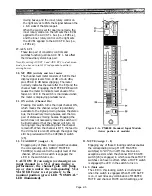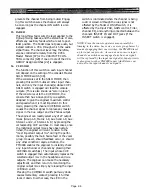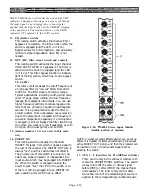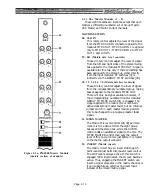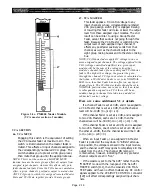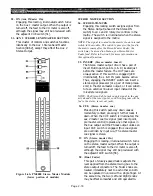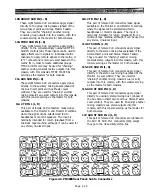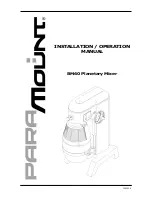
GROUP SECTION
39. PAN (group to stereo bus)
This pan control is operational only when the
adjacent GROUP-TO-ST switch is engaged. It
then pans the group signal between the left and
right sides of the stereo mixing bus. The signal is
derived after the group master fader.
40. GROUP-TO-ST
an input CUE switch is engaged. (Bus cue signals
are overriden by input cue.) The Group cue signal
is mono, regardless of how many groups are
cue’d.
45. ON (Group On)
Engaging this locking, illuminated switch assigns
the group bus output to the stereo bus via the
adjacent PAN control. When the switch is not
engaged (not illuminated), the group signal is not
applied to the stereo bus, but remains available
to the discrete group output connector.
41. GROUP-TO-MTRX
Engaging this locking, illuminated switch turns
on the GROUP OUT. When the GROUP OUT is
turned off, the feed to the VU meter is also off,
although the signal may still be previewed with
the adjacent CUE switch [44]. This switch does
not affect the group output to the matrix or the
stereo bus.
Engaging this locking switch assigns signal from
the module’s GROUP OUT (ahead of the Group
ON switch) to the correspondingly numbered
matrix rotary control. The switch is illuminated
when the group signal is assigned to the matrix.
NOTE: The signal derivation is preset by means of a
switch within each of the master modules. As shipped,
the group feed to the matrix comes after the Group
Master Fader. Moving the switch within each master
module changes this to a pre-Group Master Fader feed to
the matrix. Refer to Section 6 for more information on
this optional preset switch function.
42. GROUP MASTER FADER (Group Out Fader)
This full-length fader controls the audio signal
level from the group mixing bus which is applied
to the GROUP OUT. This is an audio fader which
controls the actual mixed audio signal, not a VCA
controller.
43. INSERT (Group insert)
The group master circuit has an insert Out/In
patch point located just before its master fader.
The OUT jack is always active. If this switch is
engaged (LED illuminated), the IN jack becomes
active. Thus, engaging the INSERT switch can
insert a signal processor in the group channel, or
it can substitute an external line-level input
instead of the mixed group signal. (This could be
useful, for example, to bring in an 8-track tape
return for rough mixdown to stereo.)
44. CUE (Group cue)
Pressing this illuminated switch part-way down
causes momentary contact; pressing it further
locks it down. When the CUE switch is illumi-
nated, the module’s GROUP OUT signal (pre
Group Master Fader) replaces any master signal
in the Cue output and the Phones output unless
Page 2-15
Summary of Contents for PM4000
Page 1: ...PROFESSIONAL AUDIO MIXING CONSOLE PM4000 OPERATING MANUAL YAMAHA ...
Page 2: ...PM4000 OPERATING MANUAL ...
Page 7: ...Section 1 Introduction ...
Page 11: ...Section 2 Brief Operating Instruction ...
Page 47: ...Section 3 Specifications ...
Page 51: ...Dimensional Drawings PM4000 Console all versions Page 3 4 ...
Page 52: ...Page 3 5 ...
Page 53: ...Page 3 6 PM4000 Console Rear Profiles ...
Page 54: ...Module Block Diagrams See back of the manual for overall system block diagram Page 3 7 ...
Page 55: ...Page 3 8 ...
Page 56: ...Page 3 9 ...
Page 57: ...Page 3 10 ...
Page 58: ...Page 3 11 ...
Page 59: ...Page 3 12 ...
Page 60: ...Section 4 Installation Notes ...
Page 72: ...Figure 4 13 Cables For Use With Balanced Sources Page 4 12 ...
Page 79: ...SECTION 5 Gain Structure and Levels ...
Page 82: ...Figure 5 1 Dynamic Range and Headroom in Sound Systems Page 5 3 ...
Page 86: ...Section 6 Optional Functions ...
Page 106: ...Section 7 Operating Notes and Hints ...
Page 119: ...Section 8 Applications ...
Page 127: ...Section 9 Maintenance ...
Page 131: ......
Page 132: ...YAMAHA VN02300 ...





